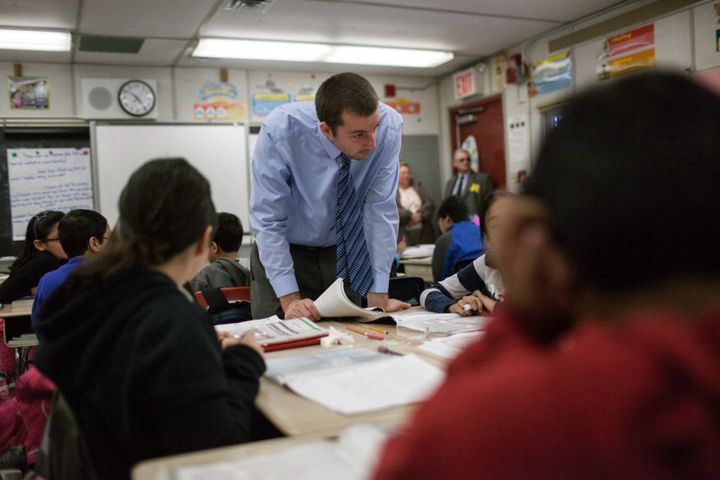
The United States bests almost every country in the world in many areas, but when it comes to educational achievement, American students are just plain mediocre. According to the 2012 results of the Programme for International Student Assessment (PISA) — a test of critical thinking administered every three years to about half a million 15-year-olds around the globe — U.S. students are lagging behind those in many other countries, including China, Finland and Korea, in math, reading and science.
PISA scores aren’t the only measure of an educational system, but most experts agree that American schools are in need of a major overhaul. The question is: What kinds of reforms will result in lasting, meaningful changes?
1. Invest in Training Teachers — and Their Bosses
The quality of a child’s teacher is extremely important to success. “As a nation, we haven’t invested in the training of our educators like we have in the training of our doctors and our lawyers. Even the best education program is going to produce a novice teacher,” Steve Fink, executive director of the Center for Educational Leadership at the University of Washington says.
We also need to improve the quality of our school and district leaders. At the Center for Educational Leadership, says Fink, “We work with teachers to improve their teaching, while simultaneously working with the school principals to help them learn how to support teachers, and simultaneously working with district leaders, superintendents and central office leaders to teach them how to support principals.”
2. Don’t Focus on Punishing Bad Teachers. Learn How to Make Good Ones Instead
You can’t hold people accountable for things they don’t know how to do. “Accountability only works if we actually help people learn and grow and teach them what they need to know in order to be held accountable. Instead we are doing the opposite,” says Fink. “We throw high-stakes testing at kids, and when test results are great, we give teachers more money. When they’re bad, we punish them and sanction them, and close down [schools]. … There’s literally zero research to support that any of these policies actually work.”
So what does work? That’s harder to say. “It’s not attributable to years of experience or what kind of degrees the teachers have... but identifying teachers’ individual strengths and weaknesses and trying to help them get better, is promising,” says Laura Hamilton, a senior behavioral scientist at the RAND Corporation, a federally funded think tank.
3. Modernize the Teacher’s Job
No teacher is an island. And yet in the traditional education model, each teacher works alone, isolated in his or her own classroom without adequate communication or support from the school — or from peers. This is “really a factory-style model,” says Lynette Guastaferro, executive director of Teaching Matters, a nonprofit advocacy group in New York City. Schools should identify who their best, most effective teachers are and then empower them to lead and help train other teachers. “What this does is two things,” says Guastaferro. “It helps solve the problem of [teacher] retention and it helps to reduce isolation, allowing [teachers] to problem-solve together.”
4. Think in Terms of Tradeoffs, Not Absolutes
The common wisdom is that children learn better in smaller classes than in big ones. But reducing class size is expensive — you need more teachers and classrooms. Here’s another costly measure: extending the school year. Yet we also know that over summer vacation, kids from poor families fall behind because they’re not engaged in the kinds of enriching activities that kids from affluent families are.
Few public school systems have the money to extend both the school year and shrink class size. “So I did a little thought experiment,” says Matt Chingos, a fellow in the Brown Center on Education Policy at the Brookings Institution, a Washington, D.C.-based research group. “What if we wanted to extend the school year … [and] compensated for that by making classrooms a little bigger?” What you find is that the “positive effect of spending more days in school is larger than the negative effect of having larger classes. It’s important to think about these tradeoffs,” he says.
5. Let Kids Learn at Their Own Pace
Schools have been hot to adopt all kinds of new technologies many of which have had a limited effect on student achievement, says RAND’s Laura Hamilton. But one especially promising strategy involves using adaptive learning programs to tailor instruction to each student — that is, “breaking away from the traditional classroom model where one teacher tells 25 kids to do the same things at the same time,” Hamilton says.
This allow kids to work at their own pace and set their own goals. It also lets teachers give more focused attention to smaller groups — while other groups work independently — instead of teaching the whole class at once.
6. Get Families Involved Early
A substantial amount of research suggests that early childhood education, when done well, may be key to kids’ achievement in the long-term. “Some of the programs that have been successful are those that include some sort of a family outreach component, so it’s not just getting the kids to the program for several hours a day, it’s involving the parents and other family members, so they are contributing to kids learning,” says Hamilton. “I think kids can benefit from that all the way through high school.”
7. Address the Issue of Poverty
Where you live often prescribes your destiny when it comes to public education. Which is why we end up with disproportionate numbers of poor kids in certain schools and wealthy ones in others. “I think there’s this argument in education: It’s poverty or it’s teacher quality. It’s actually both,” says Lynette Guastaferro of Teaching Matters. “At some point we have to address this issue of the concentration of poor kids, because that issue has gotten radically worse over the last 30 years. Until we solve that, we’ll only be filling the glass halfway.”
